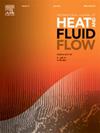Sensitivity analysis and modeling of thermophysical properties of a hybrid nanofluid by use of different intelligent techniques
IF 2.6
3区 工程技术
Q2 ENGINEERING, MECHANICAL
International Journal of Heat and Fluid Flow
Pub Date : 2025-07-16
DOI:10.1016/j.ijheatfluidflow.2025.109982
引用次数: 0
Abstract
The thermal conductivity and dynamic viscosity of nanofluids are essential factors in determining heat transfer and fluid flow characteristics. Intelligent methods have demonstrated great effectiveness for the precise estimation and modeling of these properties. The purpose of this study is to model both thermal conductivity and dynamic viscosity of a hybrid nanofluid, TiO2-SiO2/water-ethylene glycol, by application of three intelligent approaches namely Group Method of Data Handling (GMDH), Particle Swarm Optimization-Adaptive Neuro Fuzzy Inference System (PSO-ANFIS) and Genetic Algorithm-Adaptive Neuro Fuzzy Inference System (GA-ANFIS). The outcome of the study shows significant precision of the proposed models in estimation of the thermophysical properties. The most accurate models for thermal conductivity and dynamic viscosity are PSO-ANFIS and GMDH, respectively. R2 & and Average Absolute Relative Deviation (AARD) for the thermal conductivity and dynamic viscosity of the nanofluids with the most accurate models are 0.9907 & 0.41% and 0.9889 & 2.45%, respectively. Furthermore, sensitivity analysis is conducted on both properties of the nanofluid by considering temperature, concentration, and mixture ratio of the hybrid nanofluids and it is found that for both properties, temperature has the highest effect and is followed by the concentration.
基于不同智能技术的混合纳米流体热物理性质敏感性分析与建模
纳米流体的热导率和动态粘度是决定纳米流体传热和流动特性的重要因素。智能方法已经证明了对这些特性进行精确估计和建模的有效性。本研究的目的是应用三种智能方法,即群体数据处理方法(GMDH)、粒子群优化-自适应神经模糊推理系统(PSO-ANFIS)和遗传算法-自适应神经模糊推理系统(GA-ANFIS),对TiO2-SiO2/水-乙二醇混合纳米流体的热导率和动态粘度进行建模。研究结果表明,所提出的模型在估计热物理性质方面具有显著的精度。最准确的热导率和动态粘度模型分别是PSO-ANFIS和GMDH。R2,模型最精确的纳米流体导热系数和动态粘度的平均绝对相对偏差(AARD)为0.9907 &;0.41%和0.9889 &;2.45%,分别。此外,通过考虑混合纳米流体的温度、浓度和混合比例对纳米流体的两种性质进行敏感性分析,发现温度对两种性质的影响最大,其次是浓度。
本文章由计算机程序翻译,如有差异,请以英文原文为准。
求助全文
约1分钟内获得全文
求助全文
来源期刊

International Journal of Heat and Fluid Flow
工程技术-工程:机械
CiteScore
5.00
自引率
7.70%
发文量
131
审稿时长
33 days
期刊介绍:
The International Journal of Heat and Fluid Flow welcomes high-quality original contributions on experimental, computational, and physical aspects of convective heat transfer and fluid dynamics relevant to engineering or the environment, including multiphase and microscale flows.
Papers reporting the application of these disciplines to design and development, with emphasis on new technological fields, are also welcomed. Some of these new fields include microscale electronic and mechanical systems; medical and biological systems; and thermal and flow control in both the internal and external environment.
 求助内容:
求助内容: 应助结果提醒方式:
应助结果提醒方式:


